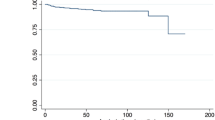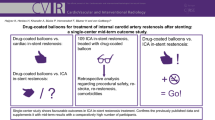Abstract
Purpose
Early in-stent restenosis after stent-protected angioplasty of the carotid artery (SPAC) is an infrequent, but potentially harmful condition for patients with carotid artery disease.
Methods
In our retrospective single-center analysis of 176 patients with carotid artery stenting between 2009 and 2015, using duplex ultrasound, we detected 9 patients with high-grade carotid artery in-stent restenosis. All restenosis patients were treated with a drug-eluting balloon (DEB) to prevent recurrent neointimal hyperplasia. One patient had bilateral carotid artery disease with bilateral in-stent restenosis, and 1 patient needed repeated DEB treatment 19 months after the first DEB intervention, so 11 DEB procedures, in total, were performed.
Results
The median time-interval between primary carotid artery stenting and first DEB-treatment was 9 months. In 3 of the 11 interventions, the DEB treatment was assisted by an additional stent. One repeat DEB treatment was necessary, and three DEB treatments were followed by a secondary stent. No peri-interventional complications (TIA, stroke, or death) were observed during or after DEB intervention. Therefore, in the entire group, the 1y event-free survival (EFS) was 100%, and the 2y/3y/5y EFS was 83%.
Conclusion
DEB intervention seems to be an effective and safe treatment for patients with high-grade in-stent restenosis after SPAC.

Similar content being viewed by others
References
Yadav JS (2004) Carotid stenting in high-risk patients: design and rationale of the SAPPHIRE trial. Cleve Clin J Med 71(Suppl 1):S45–S46
Endovascular versus surgical treatment in patients with carotid stenosis in the Carotid and Vertebral Artery Transluminal Angioplasty Study (CAVATAS): a randomised trial (2001). Lancet 357 (9270):1729–1737
Brott TG, Hobson RW 2nd, Howard G, Roubin GS, Clark WM, Brooks W, Mackey A, Hill MD, Leimgruber PP, Sheffet AJ, Howard VJ, Moore WS, Voeks JH, Hopkins LN, Cutlip DE, Cohen DJ, Popma JJ, Ferguson RD, Cohen SN, Blackshear JL, Silver FL, Mohr JP, Lal BK, Meschia JF, Investigators C (2010) Stenting versus endarterectomy for treatment of carotid-artery stenosis. N Engl J Med 363(1):11–23. https://doi.org/10.1056/NEJMoa0912321
Eckstein HH, Ringleb P, Allenberg JR, Berger J, Fraedrich G, Hacke W, Hennerici M, Stingele R, Fiehler J, Zeumer H, Jansen O (2008) Results of the Stent-Protected Angioplasty versus Carotid Endarterectomy (SPACE) study to treat symptomatic stenoses at 2 years: a multinational, prospective, randomised trial. Lancet Neurol 7(10):893–902. https://doi.org/10.1016/S1474-4422(08)70196-0
Brott TG, Howard G, Roubin GS, Meschia JF, Mackey A, Brooks W, Moore WS, Hill MD, Mantese VA, Clark WM, Timaran CH, Heck D, Leimgruber PP, Sheffet AJ, Howard VJ, Chaturvedi S, Lal BK, Voeks JH, Hobson RW 2nd, Investigators C (2016) Long-term results of stenting versus endarterectomy for carotid-artery stenosis. N Engl J Med 374(11):1021–1031. https://doi.org/10.1056/NEJMoa1505215
Gandini R, Del Giudice C, Da Ros V, Sallustio F, Altobelli S, D'Onofrio A, Abrignani S, Vasili E, Stanzione P, Simonetti G (2014) Long-term results of drug-eluting balloon angioplasty for treatment of refractory recurrent carotid in-stent restenosis. J Endovasc Ther 21(5):671–677. https://doi.org/10.1583/14-4715MR.1
Pourier VE, de Borst GJ (2016) Technical options for treatment of in-stent restenosis after carotid artery stenting. J Vasc Surg 64(5):1486–1496. https://doi.org/10.1016/j.jvs.2016.07.106
van Haaften AC, Bots ML, Moll FL, de Borst GJ (2010) Therapeutic options for carotid in-stent restenosis: review of the literature. J Vasc Interv Radiol 21(10):1471–1477. https://doi.org/10.1016/j.jvir.2010.06.010
Werk M, Langner S, Reinkensmeier B, Boettcher HF, Tepe G, Dietz U, Hosten N, Hamm B, Speck U, Ricke J (2008) Inhibition of restenosis in femoropopliteal arteries: paclitaxel-coated versus uncoated balloon: femoral paclitaxel randomized pilot trial. Circulation 118(13):1358–1365. https://doi.org/10.1161/CIRCULATIONAHA.107.735985
Gray WA, Granada JF (2010) Drug-coated balloons for the prevention of vascular restenosis. Circulation 121(24):2672–2680. https://doi.org/10.1161/CIRCULATIONAHA.110.936922
Armstrong PA, Bandyk DF, Johnson BL, Shames ML, Zwiebel BR, Back MR (2007) Duplex scan surveillance after carotid angioplasty and stenting: a rational definition of stent stenosis. J Vasc Surg 46(3):460–465; discussion 465-466. https://doi.org/10.1016/j.jvs.2007.04.073
Chi YW, White CJ, Woods TC, Goldman CK (2007) Ultrasound velocity criteria for carotid in-stent restenosis. Catheter Cardiovasc Interv 69(3):349–354. https://doi.org/10.1002/ccd.21032
Kidwell CS, el-Saden S, Livshits Z, Martin NA, Glenn TC, Saver JL (2001) Transcranial Doppler pulsatility indices as a measure of diffuse small-vessel disease. J Neuroimag: Off J Am Soc Neuroimag 11(3):229–235
North American Symptomatic Carotid Endarterectomy Trial. Methods, patient characteristics, and progress (1991). Stroke 22 (6):711–720
Massop D, Dave R, Metzger C, Bachinsky W, Solis M, Shah R, Schultz G, Schreiber T, Ashchi M, Hibbard R, Investigators SW (2009) Stenting and angioplasty with protection in patients at high-risk for endarterectomy: SAPPHIRE Worldwide Registry first 2,001 patients. Catheter Cardiovasc Interv 73(2):129–136. https://doi.org/10.1002/ccd.21844
Willfort-Ehringer A, Ahmadi R, Gruber D, Gschwandtner ME, Haumer A, Haumer M, Ehringer H (2004) Arterial remodeling and hemodynamics in carotid stents: a prospective duplex ultrasound study over 2 years. J Vasc Surg 39(4):728–734. https://doi.org/10.1016/j.jvs.2003.12.029
Lin PH, Zhou W, Guerrero MA, McCoy SA, Felkai D, Kougias P, El Sayed HF (2006) Carotid artery stenting with distal protection using the carotid wallstent and filterwire neuroprotection: single-center experience of 380 cases with midterm outcomes. Vascular 14(5):237–244
AbuRahma AF (2011) The incidence of carotid in-stent stenosis is underestimated: should it be treated or left alone? J Endovasc Ther 18(5):726–728. https://doi.org/10.1583/11-3535C.1
Gaudry M, Bartoli JM, Bal L, Giorgi R, De Masi M, Magnan PE, Piquet P (2016) Anatomical and technical factors influence the rate of in-stent restenosis following carotid artery stenting for the treatment of post-carotid endarterectomy stenosis. PLoS One 11(9):e0161716. https://doi.org/10.1371/journal.pone.0161716
Wasser K, Schnaudigel S, Wohlfahrt J, Psychogios MN, Schramm P, Knauth M, Groschel K (2012) Clinical impact and predictors of carotid artery in-stent restenosis. J Neurol 259(9):1896–1902. https://doi.org/10.1007/s00415-012-6436-3
Lal BK, Beach KW, Roubin GS, Lutsep HL, Moore WS, Malas MB, Chiu D, Gonzales NR, Burke JL, Rinaldi M, Elmore JR, Weaver FA, Narins CR, Foster M, Hodgson KJ, Shepard AD, Meschia JF, Bergelin RO, Voeks JH, Howard G, Brott TG, Investigators C (2012) Restenosis after carotid artery stenting and endarterectomy: a secondary analysis of CREST, a randomised controlled trial. Lancet Neurol 11(9):755–763. https://doi.org/10.1016/S1474-4422(12)70159-X
Montorsi P, Galli S, Ravagnani PM, Trabattoni D, Fabbiocchi F, Lualdi A, Teruzzi G, Riva G, Troiano S, Bartorelli AL (2012) Drug-eluting balloon for treatment of in-stent restenosis after carotid artery stenting: preliminary report. J Endovasc Ther 19(6):734–742. https://doi.org/10.1583/JEVT-12-4042R.1
Vajda Z, Guthe T, Perez MA, Heuschmid A, Schmid E, Bazner H, Henkes H (2011) Neurovascular in-stent stenoses: treatment with conventional and drug-eluting balloons. AJNR Am J Neuroradiol 32(10):1942–1947. https://doi.org/10.3174/ajnr.A2644
Zhou W, Lin PH, Bush RL, Peden EK, Guerrero MA, Kougias P, Lumsden AB (2006) Management of in-sent restenosis after carotid artery stenting in high-risk patients. J Vasc Surg 43(2):305–312. https://doi.org/10.1016/j.jvs.2005.10.040
Willfort-Ehringer A, Ahmadi R, Gschwandtner ME, Haumer M, Lang W, Minar E (2002) Single-center experience with carotid stent restenosis. J Endovasc Ther 9(3):299–307. https://doi.org/10.1583/1545-1550(2002)009<0299:SCEWCS>2.0.CO;2
Author information
Authors and Affiliations
Corresponding author
Ethics declarations
Funding
No funding was received for this study.
Conflict of interest
The authors declare that they have no conflict of interest.
Ethical approval
All procedures performed in the studies involving human participants were in accordance with the ethical standards of the institutional and/or national research committee and with the 1964 Helsinki Declaration and its later amendments or comparable ethical standards.
Informed consent
Informed consent was obtained from all individual participants included in the study.
Rights and permissions
About this article
Cite this article
Pohlmann, C., Höltje, J., Zeile, M. et al. Recurrent stenosis following carotid artery stenting treated with a drug-eluting balloon: a single-center retrospective analysis. Neuroradiology 60, 81–87 (2018). https://doi.org/10.1007/s00234-017-1935-7
Received:
Accepted:
Published:
Issue Date:
DOI: https://doi.org/10.1007/s00234-017-1935-7




